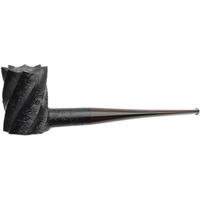NOTES FROM THE TOBACCO BAKERY
By Fred Hanna
Tired of all that tang, sharpness, and harshness in a new, nonaged Virginia ? I am offering a way to counteract it to a significant degree, without any claims of this being a substitute for good old fashioned cellaring and aging.
Being a long admirer of English mixtures for over 30 years, I prefer blends to be smooth, complex, and perhaps a bit spicy. Thus, I find the flavor of most new Virginia tobaccos, to be all too often sharp, irritating, and annoying. Although the tang often settles down and mellows out midway through the bowl, I sometimes lack the patience to get that far. To me, some of the so called "matured" Virginias are anything but mature, displaying all the manners of a rude and defiant adolescent. But a thoroughly and sufficiently aged Virginia tobacco provides one of the finest gustatory experiences on earth.
My goal has been to discover Virginias that deliver that great flavor without the rash, uncouth, unmannerly qualities of Virginias that lack the true maturity that comes with age. Thus, I have cellared a modest collection of aged Virginias to provide me with that incomparable flavor whenever my passion for this great tobacco is aroused. Smoking a great, well aged Virginia is a magical and altogether remarkable experience, reminiscent of a fine red Burgundy from the Cotes de Nuits.
Unfortunately, 10+ year old tins of Virginia can be expensive, and while not as expensive as some of their English style brethren, they can be costly nonetheless. So I have been brainstorming over the past several years, trying to come up with a way to reduce that tangy, harsh flavor, even though I knew I would not stop buying the well aged tins. More to the point, I was looking for a way to achieve a "stoving" effect that would mellow and enrich the flavor of the tobacco with little effort on my part. I believe I have found a way.
Over the past five months, I have been experimenting with a different tobacco treatment to improve the flavor of young, sharp, excessively tangy Virginias . It is a simple solution that does not require crock pots, mason jars, or blending. It may not be new, as it is likely that someone has tried this at one time or another, but I have never spoken to anyone who has tried it. So I did the early experimenting alone and then consulted with others for their perspectives. I call this technique "tin baking" or "tobacco baking" or simply "cooking."
Results so far have been exciting, but I am still experimenting. At this point, what I can report are three definite changes in the tobacco. Generally, the process makes the tobacco (1) smoother, richer, and more mellow to the taste, (2) darker in color, and (3) more intense in terms of the aroma, with an added "stewed fruit" overtone. If the tobacco you bake happens to be your favorite, the process may not make it "better," but from what I have heard from friends and fellow experimenters, it will still taste great, but different. Here's what I have been doing. It's quite simple, really. BUT TRY THIS AT YOUR OWN RISK.
I take the ENTIRE TIN, UNOPENED and STILL SEALED, of a Virginia tobacco, REMOVE THE PLASTIC TOP, and place it in the oven at a temperature of 200 degrees, for four to six hours. DO NOT REMOVE THE PAPER LABEL as this temperature is not hot enough to cause the paper to ignite. I have a specific notation for this process which I write on the tin after the cooking, describing the temp and time with a slash mark separating them. For example, if I bake a tin at 200 degrees for 5 hours, I write on the tin, 200/300. This indicates the tin was cooked at 200 degrees for 300 minutes, or five hours. The temperature is the first number, followed by the number of minutes of cooking.
While baking, the taller tins, (e.g., Rattray's or 100g McClelland) will swell and expand at the lid, and to some degree at the bottom, but they seem to reduce to normal size, or nearly so, after cooling. When cooking at a temperature that exceeds the boiling point, say at 220/140, the tin sometimes can expand and swell so much that it never completely returns to normal size.
Be careful with McClelland tins if you are cooking at or beyond 212 degrees (that is, above boiling point). Some will pop open with a loud "plunk/woosh" sort of sound, and spill their contents all over the bottom of the oven, filling the house with a roasted tobacco odor. I have found that, while this result is rather amusing to me, my wife does not see this as humorous. After having had several experiences with exploding tins, I cook the McClelland tins at around 200/300, or some variation thereof, below the boiling point. With some Rattray tins, Pease tins, or the short McClelland tins, 220/140 seems to work fine. Generally, however, I recommend 200/300 as a starting point for experimenting with all tobaccos.
I have been asked what is the proper cooling period for cooked tins, before opening the tin. Greg Pease once said that a tobacco will continue to change for several days after stoving. This may well be true, and Greg no doubt knows what he is talking about. However, with my limited knowledge and experience I cannot say for sure. What little experience I do have, shows that the flavors are fine regardless of how long I wait to open them. For example, I have opened the latest version of McCranie's Red Ribbon within an hour, and after a week, of cooking. Both tasted great. BEFORE SMOKING THE TOBACCO HOWEVER, I USUALLY WAIT A DAY OR TWO AFTER OPENING THE TIN.
THE FLAT TINS of Virginia are a slightly different story. Tins such as Escudo and Solani 633 DO POP THEIR SEAL WHILE BAKING but the result is still positive. Surprisingly, the tobacco inside does not dry out or become "roasted" or burnt, and its moisture seems to be largely retained. Here again, I recommend cooking these at 200/300 as well. After cooling for a few hours, I remove the tobac from the baked flat tin and place it in a separate container.
THE RESULTS? As I said earlier, this process seems to change the tobacco in such a way as to, like stoving, make the tobac more dark in color. Cooking also makes the tobacco smoke more mellow, smooth, and sometimes more sweet. If you try it yourself, you will also see how the aroma of the tobacco is highly affected, positively, in my opinion, but not always better. Many experienced pipe smoking friends who have smoked tins thus treated agree that it improves many young Virginias , and produces interesting variations in any case. You will not be surprised to learn that tin baking, or cooking, is now a frequent topic of conversation among members of our Chesapeake Pipe Club.
Is tin baking the same as stoving? Hell, I don't know but I suppose so. Actually, I don't know what the hell I am doing. But I do know that I will be doing tin baking regularly for certain tobaccos. Try 200/300 with a tangy, sharp 2003 or 2004 McClelland Christmas Cheer and see how it mellows, darkens, and behaves more like a matured Virginia . I found that 200/300 makes the current version of McCranie's Red Ribbon smoke downright heavenly--smooth, rich, sweet, and creamy. I love the older Red Ribbon tobacco aged, but the baking method gives the new version an entirely new dimension that I like just as much. And with McClelland Virginias, the wine/vinegar aroma that some souls do not like, reduces significantly, just as it does with aging. This method at 220/140 made a tin of Rattray's Marlin Flake smell like oatmeal raisin cookies (must be some topping they put on it), but the topping seemed to meld nicely with the tobacco, which took a different, though not necessarily better, flavor.
Escudo is distinctly improved by this method, in my opinion. In the opinion of some other Escudo fans, 200/300 merely produces an excellent variation. The "wheels" or "curlies" reduce in size, turn much darker, and, to my taste, the smoke becomes more substantial, rich, and tasty. A friend, who is an Escudo fan, baked Escudo at 180/360 and raved about the improvement, calling it "the best" and "wonderful." In the case of Solani 633, the tobacco takes on a noticeably creamy flavor at 220/140, and is much more smooth. Several pipe smokers have tried this with GLP Haddo's Delight and reported positive results. I found that at 220/140 Haddo's takes on a highly pleasant, subdued sweetness that was not previously present in the blend.
The added sweetness could be due to the heat breaking down the natural starches in the tobacco leaf, freeing the glucose molecules that make up the starch itself. Just as cooking mellows and sweetens carrots, onions, and garlic, it may be that a similar process is occurring with baking tobacco. Having said that, please understand that this is pure speculation as I really do not know.
I have not tried this method with aromatics and probably will not. As for English tobaccos, I have baked a few but am not ready to report on those at this time. Meanwhile, my experimentation, and fun, continues. ALLOW ME TO REPEAT THAT TIN BAKING IS NOT MEANT TO BE A SUBSTITUTE FOR THE AGING PROCESS, but it sure does seem to make some Virginias much more smokable in the near term. Like I said before, try this at your own risk. I would interested in hearing from anyone who tries tin baking and wants to share their experiences and impressions.













